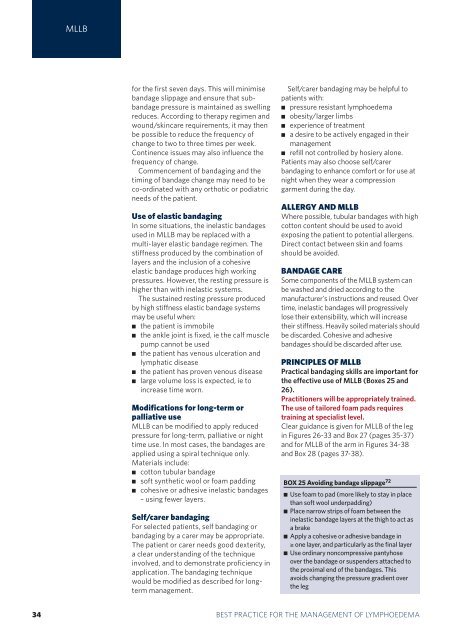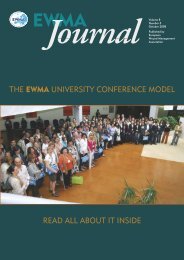best practice for the management of lymphoedema ... - EWMA
best practice for the management of lymphoedema ... - EWMA
best practice for the management of lymphoedema ... - EWMA
You also want an ePaper? Increase the reach of your titles
YUMPU automatically turns print PDFs into web optimized ePapers that Google loves.
MLLB<br />
<strong>for</strong> <strong>the</strong> first seven days. This will minimise<br />
bandage slippage and ensure that subbandage<br />
pressure is maintained as swelling<br />
reduces. According to <strong>the</strong>rapy regimen and<br />
wound/skincare requirements, it may <strong>the</strong>n<br />
be possible to reduce <strong>the</strong> frequency <strong>of</strong><br />
change to two to three times per week.<br />
Continence issues may also influence <strong>the</strong><br />
frequency <strong>of</strong> change.<br />
Commencement <strong>of</strong> bandaging and <strong>the</strong><br />
timing <strong>of</strong> bandage change may need to be<br />
co-ordinated with any orthotic or podiatric<br />
needs <strong>of</strong> <strong>the</strong> patient.<br />
Use <strong>of</strong> elastic bandaging<br />
In some situations, <strong>the</strong> inelastic bandages<br />
used in MLLB may be replaced with a<br />
multi-layer elastic bandage regimen. The<br />
stiffness produced by <strong>the</strong> combination <strong>of</strong><br />
layers and <strong>the</strong> inclusion <strong>of</strong> a cohesive<br />
elastic bandage produces high working<br />
pressures. However, <strong>the</strong> resting pressure is<br />
higher than with inelastic systems.<br />
The sustained resting pressure produced<br />
by high stiffness elastic bandage systems<br />
may be useful when:<br />
■ <strong>the</strong> patient is immobile<br />
■ <strong>the</strong> ankle joint is fixed, ie <strong>the</strong> calf muscle<br />
pump cannot be used<br />
■ <strong>the</strong> patient has venous ulceration and<br />
lymphatic disease<br />
■ <strong>the</strong> patient has proven venous disease<br />
■ large volume loss is expected, ie to<br />
increase time worn.<br />
Modifications <strong>for</strong> long-term or<br />
palliative use<br />
MLLB can be modified to apply reduced<br />
pressure <strong>for</strong> long-term, palliative or night<br />
time use. In most cases, <strong>the</strong> bandages are<br />
applied using a spiral technique only.<br />
Materials include:<br />
■ cotton tubular bandage<br />
■ s<strong>of</strong>t syn<strong>the</strong>tic wool or foam padding<br />
■ cohesive or adhesive inelastic bandages<br />
– using fewer layers.<br />
Self/carer bandaging<br />
For selected patients, self bandaging or<br />
bandaging by a carer may be appropriate.<br />
The patient or carer needs good dexterity,<br />
a clear understanding <strong>of</strong> <strong>the</strong> technique<br />
involved, and to demonstrate pr<strong>of</strong>iciency in<br />
application. The bandaging technique<br />
would be modified as described <strong>for</strong> longterm<br />
<strong>management</strong>.<br />
Self/carer bandaging may be helpful to<br />
patients with:<br />
■ pressure resistant <strong>lymphoedema</strong><br />
■ obesity/larger limbs<br />
■ experience <strong>of</strong> treatment<br />
■ a desire to be actively engaged in <strong>the</strong>ir<br />
<strong>management</strong><br />
■ refill not controlled by hosiery alone.<br />
Patients may also choose self/carer<br />
bandaging to enhance com<strong>for</strong>t or <strong>for</strong> use at<br />
night when <strong>the</strong>y wear a compression<br />
garment during <strong>the</strong> day.<br />
ALLERGY AND MLLB<br />
Where possible, tubular bandages with high<br />
cotton content should be used to avoid<br />
exposing <strong>the</strong> patient to potential allergens.<br />
Direct contact between skin and foams<br />
should be avoided.<br />
BANDAGE CARE<br />
Some components <strong>of</strong> <strong>the</strong> MLLB system can<br />
be washed and dried according to <strong>the</strong><br />
manufacturer's instructions and reused. Over<br />
time, inelastic bandages will progressively<br />
lose <strong>the</strong>ir extensibility, which will increase<br />
<strong>the</strong>ir stiffness. Heavily soiled materials should<br />
be discarded. Cohesive and adhesive<br />
bandages should be discarded after use.<br />
PRINCIPLES OF MLLB<br />
Practical bandaging skills are important <strong>for</strong><br />
<strong>the</strong> effective use <strong>of</strong> MLLB (Boxes 25 and<br />
26).<br />
Practitioners will be appropriately trained.<br />
The use <strong>of</strong> tailored foam pads requires<br />
training at specialist level.<br />
Clear guidance is given <strong>for</strong> MLLB <strong>of</strong> <strong>the</strong> leg<br />
in Figures 26-33 and Box 27 (pages 35-37)<br />
and <strong>for</strong> MLLB <strong>of</strong> <strong>the</strong> arm in Figures 34-38<br />
and Box 28 (pages 37-38).<br />
BOX 25 Avoiding bandage slippage 72<br />
■ Use foam to pad (more likely to stay in place<br />
than s<strong>of</strong>t wool underpadding)<br />
■ Place narrow strips <strong>of</strong> foam between <strong>the</strong><br />
inelastic bandage layers at <strong>the</strong> thigh to act as<br />
a brake<br />
■ Apply a cohesive or adhesive bandage in<br />
≥ one layer, and particularly as <strong>the</strong> final layer<br />
■ Use ordinary noncompressive pantyhose<br />
over <strong>the</strong> bandage or suspenders attached to<br />
<strong>the</strong> proximal end <strong>of</strong> <strong>the</strong> bandages. This<br />
avoids changing <strong>the</strong> pressure gradient over<br />
<strong>the</strong> leg<br />
34 BEST PRACTICE FOR THE MANAGEMENT OF LYMPHOEDEMA

















